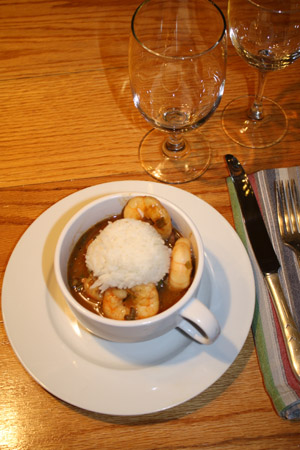















Soul Food
Jumbo Gumbo
Of all the good things that people on the Gulf Coast like to eat, nothing speaks to the rich cultural diversity we share more than gumbo. Even the name of this dish comes to us from the African Bantu peoples and tells us that the okra that we often use in gumbo came from that far off continent. Many fingers have stirred this pot. The Spanish, French, Native Americans, African slaves, highbrow Creoles and fun-loving Cajuns all contributed something. Gumbo first starts showing up in cookbooks at the beginning of the nineteenth century. The French Creoles take credit for gumbo, but the recipe harkens back to the bouillabaisse French fishermen made on the beach after returning from a day at sea. The Holy Trinity---onion, celery and bell pepper---that are always a part of this dish have origins in Spanish sofrito, and the filé we often use is from the Choctaw peoples.
There are three basic categories of gumbo, depending on the thickening ingredient you use. Roux and okra are the most common, but are never used together. Filé, the third, is used most often in a non-seafood gumbo, and was originally used in the winter when okra might not be available. The thickening agents are an integral part of the cooking process. However, filé is added individually when the gumbo is served. Thickening a gumbo with roux is a modern adaptation, and will not be found in early recipes.
There is also a slight difference in the two basic recipes for gumbo. Creole gumbo is not as dark as a Cajun gumbo, due to the use of a lighter roux, and Cajun gumbo often contains tomato.
Having said all of that, there really are very few rules in making a good gumbo. A flavorful base stock, onions, celery and bell peppers are pretty crucial, but if you've got to you can leave one out or add another. You can use one of the traditional thickeners or you can use corn starch. Almost any combination of seafood, foul, meat, game, sausage or vegetable can be used, and it's fun to play with the different combinations.
One word of caution! A good gumbo is not hard to make, but it does take time. If you rush a gumbo you will not give it the time it needs to develop the rich and deep flavors it is famous for. Cook it slow and low, but do not overcook the seafood.
Here's a pretty basic shrimp, sausage and chicken gumbo that I love to make. I think of it as a summertime recipe because I use only okra as a thickener, and that makes it a little lighter. I call it "Jumbo Gumbo" because I like to use the largest shrimp I can find, in contrast to the silly idea that the tiniest shrimp make a better gumbo. Smaller shrimp are not more flavorful and merely tease your palate with a hint of the robust flavor a full size shrimp offers.
There are three basic categories of gumbo, depending on the thickening ingredient you use. Roux and okra are the most common, but are never used together. Filé, the third, is used most often in a non-seafood gumbo, and was originally used in the winter when okra might not be available. The thickening agents are an integral part of the cooking process. However, filé is added individually when the gumbo is served. Thickening a gumbo with roux is a modern adaptation, and will not be found in early recipes.
There is also a slight difference in the two basic recipes for gumbo. Creole gumbo is not as dark as a Cajun gumbo, due to the use of a lighter roux, and Cajun gumbo often contains tomato.
Having said all of that, there really are very few rules in making a good gumbo. A flavorful base stock, onions, celery and bell peppers are pretty crucial, but if you've got to you can leave one out or add another. You can use one of the traditional thickeners or you can use corn starch. Almost any combination of seafood, foul, meat, game, sausage or vegetable can be used, and it's fun to play with the different combinations.
One word of caution! A good gumbo is not hard to make, but it does take time. If you rush a gumbo you will not give it the time it needs to develop the rich and deep flavors it is famous for. Cook it slow and low, but do not overcook the seafood.
Here's a pretty basic shrimp, sausage and chicken gumbo that I love to make. I think of it as a summertime recipe because I use only okra as a thickener, and that makes it a little lighter. I call it "Jumbo Gumbo" because I like to use the largest shrimp I can find, in contrast to the silly idea that the tiniest shrimp make a better gumbo. Smaller shrimp are not more flavorful and merely tease your palate with a hint of the robust flavor a full size shrimp offers.
Jumbo Gumbo
(Feeds 4-6)
4 chicken thighs
8 ounces smoked sausage, sliced into ½" thick pieces
2 pounds peeled jumbo shrimp
2 cups sliced okra
1 chopped onion
1 chopped green bell pepper
1 cup chopped celery
6-8 cloves finely chopped garlic
1 pinch red pepper flakes
Black pepper to taste
Cajun seasoning to taste
(Feeds 4-6)
4 chicken thighs
8 ounces smoked sausage, sliced into ½" thick pieces
2 pounds peeled jumbo shrimp
2 cups sliced okra
1 chopped onion
1 chopped green bell pepper
1 cup chopped celery
6-8 cloves finely chopped garlic
1 pinch red pepper flakes
Black pepper to taste
Cajun seasoning to taste

Sauté the chicken thighs that have been seasoned with salt and black pepper in good oil until brown. Add 10 cups of water and simmer for 30 minutes. Remove the chicken, cool and remove the meat from the bone. Set the meat aside. The cooking liquid is your stock. You can skip this step if you are using a prepared chicken stock, but it is not recommended.
Sauté the okra in oil until it starts to come apart (15 minutes or so) over medium heat. Then add the rest of the vegetables and the sausage. Sauté over medium heat for at least 15 more minutes, stirring often. Do not shorten the cooking time of the vegetables! Season with black pepper, red pepper flakes and Cajun seasoning to your taste. Taste and season again if needed. Add the chicken you removed from the bone. Add all of the stock, and simmer for one hour over low heat.
Season the raw shrimp with the Cajun seasoning. Heat 1/8th of an inch of oil in a heavy pan. When just starting to smoke, add the shrimp and cook very quickly, stirring often and making sure all cook on both sides. Do not cook the shrimp more than two minutes. Add the shrimp to the gumbo and take it off the stove. Let the gumbo rest for at least thirty minutes. Serve with white rice.
Have fun cooking. Have a better time eating.
Sauté the okra in oil until it starts to come apart (15 minutes or so) over medium heat. Then add the rest of the vegetables and the sausage. Sauté over medium heat for at least 15 more minutes, stirring often. Do not shorten the cooking time of the vegetables! Season with black pepper, red pepper flakes and Cajun seasoning to your taste. Taste and season again if needed. Add the chicken you removed from the bone. Add all of the stock, and simmer for one hour over low heat.
Season the raw shrimp with the Cajun seasoning. Heat 1/8th of an inch of oil in a heavy pan. When just starting to smoke, add the shrimp and cook very quickly, stirring often and making sure all cook on both sides. Do not cook the shrimp more than two minutes. Add the shrimp to the gumbo and take it off the stove. Let the gumbo rest for at least thirty minutes. Serve with white rice.
Have fun cooking. Have a better time eating.
Author: Julian G. Brunt. Published November 14, 2010.
Copyright
Southern Edition
All Rights Reserved
Southern Edition
All Rights Reserved
All materials contained on this site, including text and images, are protected by copyright laws and may not be reproduced without prior written permission from the publisher. Where applicable, use of some items contained on this site may require permission from other copyright owners.
Fair Use of text from SouthernEdition.com does is permitted to the extent allowed by copyright law. Proper citation is requested. Please use this guide when citing a Southern Edition article.
Contact Greg Freeman or SouthernEdition.comFair Use of text from SouthernEdition.com does is permitted to the extent allowed by copyright law. Proper citation is requested. Please use this guide when citing a Southern Edition article.
